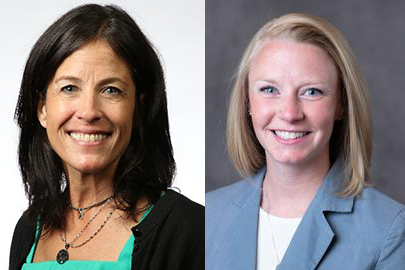
Now Enrolling: The APOLLO clinical trial is studying an additional treatment option after standard therapy for certain patients with pancreatic cancer
September 20, 2021
Trial Results: Blood cancers are the focus of recent ECOG-ACRIN research
December 15, 2021The language of (lung) cancer

Jill Feldman (left) of ECOG-ACRIN and the IASLC and Kristin Ito of the IASLC
It’s not what you say—it’s how you say it.
It’s a common adage, and though it may be applicable in many arenas, the field of oncology is not one of them. When it comes to communicating about cancer, it is increasingly apparent that it is what you say that matters.
“Medical language is rooted in history and tradition,” says Jill Feldman, a lung cancer survivor and member of the ECOG-ACRIN Cancer Research Group’s Cancer Research Advocates Committee. “But over time, we have come to recognize certain words and phrases as harmful and stigmatizing.”
What led to this recognition? In part, greater access for patients, facilitated by technology, to resources like research journals and electronic medical records. For the first time, patients could view the language their care team used to describe them. Though this language was not created to be harmful—but simply concise—it was also not created with patients in mind.
“Ten years ago, very few patients and advocates went to medical conferences or read research journals,” says Ms. Feldman. “They weren’t on social media interacting with physicians and scientists.”
Now, in an era where patients do all of the above, and an increasing number of physicians are viewing them as partners, the language of oncology must evolve—to one of mutual respect. This fact is reinforced by the recent efforts of several professional societies. In the area of lung cancer, the International Association for the Study of Lung Cancer (IASLC) recently published a Language Guide to encourage members to employ respectful language at conferences and in written abstracts. It follows in step with the American Society of Clinical Oncology’s (ASCO) Language of Respect.
Ms. Feldman, who also serves on IASLC’s Patient Advocates Committee, co-led this project with Kristin Ito, the IASLC's Patient Advocacy Manager. Ms. Ito is also the Associate Director for the IASLC's International Lung Cancer Foundation. Below, the two discuss the guide and the impact they hope it will have on the oncology and advocacy communities.
What inspired the IASLC Language Guide?
Jill Feldman (JF): There has recently been a lot of movement in oncology toward using person-first, respectful language, such as saying 'patient with cancer' instead of 'cancer patient.' However, a stigma exists in lung cancer that does not exist in most other cancer types related to smoking as a risk factor. There is a strong culture of blame that you do not see with other diseases.
In the lung cancer community, patients are defined by their smoking status. We are labeled 'smokers,' 'former smokers,' or 'nonsmokers.' That is a single story and it does not provide any information about the rest of our complex, rich lives. We need to move away from that both on the clinician side and on the advocacy side. It is divisive even within our community. When a person who is newly diagnosed feels the need to emphasize that they never smoked, that unintentionally shifts blame on people with a smoking history. That is the nuance of lung cancer and an added element that the IASLC Language Guide addresses.
Kristin Ito (KI): The Language Guide developed from Jill’s passion for this subject. Right now, we are seeing an emphasis in society on the importance of language. People are more cognizant of what they are saying and how they are saying it. This project aligned very nicely with where the IASLC is moving, and the expectations we must have of each other. The beauty of the guide is that, while the focus was initially on care team members, it lends itself to the whole community and even to other diseases.
JF: The language that we use reflects our attitudes, and our attitudes reflect our actions. Within the advocacy community, we are encouraging one another to think about this. We all have a desire to change the way we are talked about and the way the disease is talked about.
How do you see this language guide being used?
JF: I would like to see the guide adopted broadly. You commonly see language guides or articles in other situations—for people with autism, diabetes, or HIV/AIDS. This is a fluid resource, so I hope it continues to evolve. More than anything, I hope that it provides the empathy, respect, and care that people diagnosed with lung cancer and their families deserve.
KI: My goal is for the guide to improve communication and the output of care from members of care teams. Within the advocate community, I hope the guide promotes an increase in understanding and support. There is so much to talk about in the lung cancer community, but it needs to be discussed in the right way.
Can you share some examples from the guide of phrases or expressions to avoid and suggested alternatives?
JF: For smoking, 'a person who smokes' or 'a person with smoking history' rather than 'a smoker' or 'a former smoker.'
KI: 'A person with nicotine dependence' instead of 'a nicotine addict.'
JF: Yes, because nicotine is an addiction, and addiction is a disease—not a bad habit. Most of the other examples could apply to all cancers. 'The treatment failed the patient' instead of 'the patient failed treatment.'
KI: The guide is a reminder to care teams that they are treating people, not 'subjects.' These small changes have the potential to impact the level of care. For example, if you shift the focus away from nicotine habits, the conversation becomes more of a shared discussion rather than a reprimand. The patient may be more receptive to their doctor’s recommendations.
What are the key takeaways from the guide?
JF: It is okay to make mistakes. The best thing you can do is correct yourself. The guidelines can also be used beyond presentations and written abstracts. When clinicians write patient vignettes or give patient presentations, they usually begin with something that may be stigmatizing like age, gender, presumed race, or smoking status. Immediately, those lead to associations. Their language can impact the attitudes of other healthcare providers and in turn, affect the care that is provided.
KI: I hope that someone takes time away to just think about the recommendations. Even if they disagree, hopefully, they will reflect on why they disagree. As time goes on, the prevalence of these damaging phrases in the community will become more apparent. We have the opportunity to change that.

